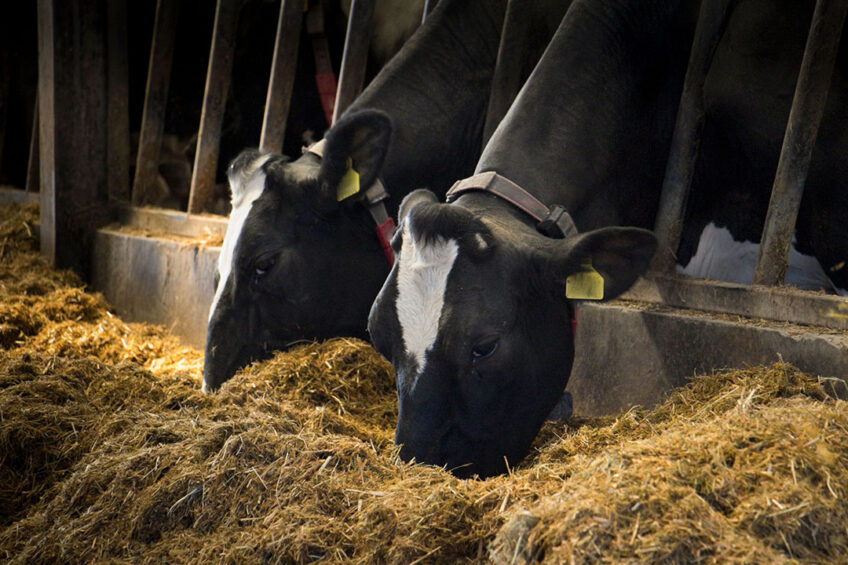Feeding postpartum cows successfully

Feeding management in high-producing cows is critical to adapt successfully to lactation, to maintain blood calcium and rumen health, and to sustain reproductive efficiency during postpartum period.
Proper diet formulation meets nutrient requirements of cows, prevents over-consumption of energy, improves transition period outcome, and increases fertility.
Impact of negative energy balance
Negative energy balance during early lactation occurs due to the lack of consuming sufficient energy-yielding nutrients from voluntary dry matter intake after calving to meet energetic requirements for milk production. Negative energy balance detrimentally affects fertility and reproductive performance by influencing hypothalamic, pituitary, and ovarian function, causing hindered resumption of ovarian cyclicity, affecting oocyte or corpus luteum quality, viability, and function, and developing fatty liver.
Early ovulation after calving increases fertility rate; however, negative energy balance:
- decreases the pulse frequency of LH release,
- size and development rate of follicles,
- concentrations of oestrogen and progesterone, and
- the size of the corpus luteum.
In addition, blood borne metabolites from responses to negative energy balance deleteriously affect oocytes and corpus luteum. Furthermore, fatty liver and hepatic lipid infiltration, which are indirectly caused by extreme negative energy balance, reduce fertility and reproduction.
How does a cow adapt from gestation to lactation?
Insulin and leptin have higher concentrations during the dry period than early lactation and promote energy storage in adipose tissue. Nutrient demands by the foetal calf and placenta peak 3 weeks before calving; however, dry matter intake decreases by 10% to 30% compared to early dry period.
Ketosis
Low dry matter intake accompanied with stressors leads to negative energy balance before calving which worsens after calving. Around calving, the insulin concentration reduces and growth hormone concentration increases to mobilise stored fat and support milk production. However, decreased dry matter intake and limited glucose supply due to negative energy balance, and the accumulation of liver fat, result in ketosis and fatty liver.
Mastitis
Loss of muscle mass starts before calving and during the first week after calving muscle protein mobilisation is increased. During transition period, immune system function is reduced, which, in turn, leads to the high incidence of environmental mastitis and metritis and increased rate of retained placenta.
Milk fever
Lactation requires a tremendous amount of calcium and causes low blood calcium at calving, milk fever and displaced abomasum by reducing smooth muscle function of the digestive tract. In addition, low blood calcium compromises immune cell function.
Feeding strategies to get the best outcome
Dry matter intake plays an important role in the depth and duration of negative energy balance. Therefore, feeding strategies for fresh cows should focus on promoting appetite and dry matter intake after calving.
Proper diet formulation is based on considering nutrient requirement of most cows and providing a balanced diet.
To promote good appetites and dry matter intake after calving:
- Diminishing environmental stressors,
- increasing cow comfort,
- preventing excessive BCS,
- inhibiting over-consumption of energy relative to requirements during the dry period,
- providing sufficient fibre,
- preventing excessive starch intake after calving,
- increasing the dietary cation-anion difference in fresh cow diet
Diet formulation in dry period or close-up period:
Proper dietary formulation during the dry period or close-up period will maintain or enable rumen adaptation to higher grain diets after calving and improve early lactation productivity. Cows need to be fed a low-energy far-off diet for 5 weeks followed by a higher-energy diet for the last 3 weeks before parturition for sufficient ruminal adaptation.
Subacute ruminal acidosis:
This is a concern in fresh cows caused by a sudden increase in dietary energy density. Subacute ruminal acidosis decreases dry matter intake and nutrient digestibility. Furthermore, adequate physical form of the diet, starch content, and fermentability are essential to stimulate ruminal activity and chewing behaviour.
Diets for fresh cows:
A moderate starch content (approximately 23-25% of dry matter) with moderate fermentability along with adequate effective forage fibre is appropriate for fresh cows. Feeding a glucogenic diet until cows resume ovarian cyclicity followed by a higher fat diet during the breeding period improve reproductive success. Supplementing polyunsaturated fatty acids such as calcium salts of safflower oil and calcium salts of fish oil improve uterine health and increase pregnancy rates and milk production.
Conclusion
Application of targeted feeding strategies to improve dry matter intake in fresh cows decreases health problems, minimises negative energy balance, and improves fertility. Although, little is known about the diet formulation for the immediate postpartum period, thus, further research is required to optimise transition success and subsequent reproduction.











